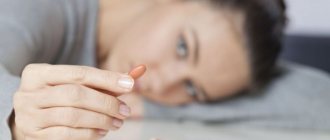Phenazepam is a tranquilizer from the group of benzodiazepines. In medicine it is used as a sedative, hypnotic, anticonvulsant and muscle relaxant. When consumed, it causes mild euphoria and relaxation, which has become the reason for its use for recreational purposes. The drug is not included in the list of narcotic drugs, but with its long-term use, dependence appears and withdrawal syndrome develops. In case of drug poisoning, symptoms of overdose appear and death may occur.
Effect on the body
The action of Phenazepam, like other benzodiazepines, is based on enhancing the action of GABA (gamma aminobutyric acid), the main inhibitory neurotransmitter of the central nervous system. The increased inhibition of neurons in subcortical formations caused by it determines the main effects of the use of Phenazepam:
- sedative;
- anxiolytic;
- muscle relaxant;
- anticonvulsant;
- hypnotic.
Phenazepam is the most popular tranquilizer in the internal medicine clinic.
Relieving anxiety, autonomic disorders, normalizing sleep, the drug helps to quickly normalize the patient’s condition in many diseases. For recreational purposes, Phenazepam is taken in increased dosages, which has a negative effect on the body.
Physiological symptoms
When using Phenazepam in large doses, the following negative symptoms are observed:
- decreased blood pressure;
- tachycardia;
- disturbance of appetite and stool;
- urinary dysfunction (urinary retention or incontinence);
- pale skin;
- chills.
From the peripheral nervous system:
- slowing of psychomotor reactions;
- slurred speech;
- unsteady gait;
- trembling of limbs;
- headache, dizziness.
Psycho-emotional manifestations
The following manifestations are observed from the psyche:
- drowsiness;
- confusion;
- general disorientation;
- restlessness;
- slurred talkativeness;
- unproductive activity.
Mental manifestations are mainly determined by individual tolerance to tranquilizers - in some patients, even therapeutic doses of the drug can cause fainting or severe headache.
Comparison of the effectiveness of Donormil and Phenazepam
Phenazepam is more effective than Donormil - this means that the ability of the drug substance to provide the maximum possible effect is different.
For example, if the therapeutic effect of Phenazepam is more pronounced, then with Donormil it is impossible to achieve this effect even in large doses.
Also, the speed of therapy is an indicator of the speed of the therapeutic action; Phenazepam and Donormil are also different, as is bioavailability - the amount of the drug reaching the site of its action in the body. The higher the bioavailability, the less it will be lost during absorption and use by the body.
Signs of a drug addict
When taking Phenazepam for recreational purposes, the dose of the drug significantly exceeds the therapeutic dose (4-6 tablets at a time). The clinic for drug intoxication is very similar to the clinic for alcohol intoxication:
- disinhibition against the background of high spirits;
- unproductive motor activity;
- liveliness, talkativeness, slurred, confused speech;
- loss of coordination of movements, unsteadiness of gait;
- pallor of the skin.
When the effect of the drug ends, the following appear:
- lethargy, drowsiness;
- severe physical weakness.
These symptoms can vary significantly from person to person, so a final conclusion about tranquilizer addiction can only be made by a narcologist after a laboratory examination.
Comparison of the safety of Donormil and Phenazepam
The safety of a drug includes many factors.
At the same time, in Donormil it is quite similar to Phenazepam. It is important where the drug is metabolized: drugs are excreted from the body either unchanged or in the form of products of their biochemical transformations. Metabolism occurs spontaneously, but most often involves major organs such as the liver, kidneys, lungs, skin, brain and others. When assessing the metabolism of Donormil, as well as of Phenazepam, we look at which organ is the metabolizing organ and how critical the effect on it is.
The risk-benefit ratio is when the prescription of a drug is undesirable, but justified under certain conditions and circumstances, with the obligatory observance of caution in use. At the same time, Donormil does not have any risks when used, just like Phenazepam.
Also, when calculating safety, it is taken into account whether only allergic reactions occur or possible dysfunction of the main organs. In other matters, as well as the reversibility of the consequences of using Donormil and Phenazepam.
Harm from drugs
Phenazepam, taken long-term in large dosages, has a negative effect on all somatic systems and organs, as well as on the function of the central nervous system and peripheral nervous system:
- from the cardiac system - surges in blood pressure, tachycardia;
- from the blood – the number of formed elements in the peripheral blood decreases;
- from the gastrointestinal tract - increased salivation, nausea, vomiting, heartburn, unstable stool, possible jaundice;
- from the kidneys and liver - the development of failure of these organs;
- from the central nervous system and peripheral nervous system - the development of drug dependence, memory impairment, problems with orientation, severe headaches and muscle pain, tremors of the limbs.
Consequences of long-term use
In the clinic, Phenazepam is prescribed in minimal dosages for a period of no more than a week. Long-term use of large doses of the drug leads to dysfunction of internal organs, peripheral and central nervous systems:
- myocardial dystrophy;
- renal failure;
- toxic hepatitis;
- severe sleep disturbances;
- rapid development of mental and physical dependence;
- convulsive readiness, muscle twitching,
- emotional lability, anxiety, aggressiveness;
- instability of attention, inability to assimilate any information;
- depression;
- polydrug addiction,
- suicide.
Professional call center
Our consultants have gone through the school of addiction, they know everything about treatment, why breakdowns happen, and how relatives should behave. We provide psychological services if necessary
8
Free consultation 24/7. Call or leave a request
Danger of consumption methods
In the pharmacy chain, Phenazepam is sold in two dosage forms: in tablet form for oral use and in ampoule form for intramuscular and intravenous administration.
Both dosage forms can be used for recreational purposes.
With frequent oral use of large doses of a tranquilizer, all chronic diseases of the gastrointestinal tract are aggravated, in addition, the drug damages the mucous membrane of the digestive tract, causing erosions and ulcers. The most commonly used injection method of administering the drug, which can lead to an overdose of a tranquilizer. In addition, this method of administration often leads to infection (HIV, viral hepatitis, sepsis).
Comparison of ease of use of Donormil and Phenazepam
This includes dose selection taking into account various conditions and frequency of doses. At the same time, it is important not to forget about the release form of the drug; it is also important to take it into account when making an assessment.
The ease of use of Donormil is approximately the same as that of Phenazepam. However, they are not convenient enough to use.
The drug ratings were compiled by experienced pharmacists who studied international research. The report is generated automatically.
Last update date: 2020-12-04 13:46:30
Drug overdose
When using Phenazepam for medicinal purposes, its dosage is 2.5-5.0 mg per day, but if the drug is used for recreational purposes, the dose of the substance taken is 4-6 times higher. Therefore, acute tranquilizer poisoning often occurs.
The main signs of overdose are:
- confused, unclear consciousness;
- decreased blood pressure;
- bradycardia;
- decreased number of respiratory movements;
- nausea, vomiting, hypersalivation;
- tremor of the limbs, sometimes convulsions;
- nystagmus.
In case of severe overdose:
- shallow irregular breathing;
- a sharp drop in blood pressure;
- bradycardia with severe forms of arrhythmia;
- coma.
Main reasons
The main causes of Phenazepam overdose are:
- quickly emerging and rapidly increasing tolerance to the drug;
- frequent use of Phenazepam with alcohol to enhance the narcotic effect;
- suicide.
First aid
At the first signs of an overdose, it is necessary to call a specialized team. Before the doctor arrives:
- if the patient is conscious: rinse the stomach, give enterosorbent (Enterosgel, Smecta);
- if there is no consciousness: put the victim on his side, wrap him in a blanket, and if breathing or heartbeat stops, perform indirect cardiac massage and artificial respiration.
Health care
At the prehospital stage:
- if the victim is unconscious, rinse the stomach with a thick probe;
- Oxygen support is provided and, if necessary, mechanical ventilation;
- as detoxification therapy, saline solutions and glucose are administered intravenously;
- use cardiotonics to maintain heart function (Dobutrex, Dopamine, Mildrinon);
- analeptics to stimulate the respiratory center (caffeine, cordiamine).
Stationary stage:
- continue treatment started at the prehospital stage.
- the antidote of Phenazepam is administered - Flumazenil - a benzodiazepine receptor antagonist (the use of the antidote is allowed only in a hospital);
- carry out drug and hardware (hemosorption, hemodialysis) detoxification.
Consequences of lack of help
In the absence of help in cases of severe poisoning, death may occur as a result of stopping the vasomotor and respiratory centers.
For milder poisonings, the following complications are possible:
- cerebellar ataxia;
- severe pneumonia;
- severe pyelonephritis;
- liver dysfunction;
- depression.
Lethal dose
The maximum therapeutic dose of Phenazepam is 10 mg; exceeding this dose leads to an overdose, and a single dose of 20 mg or a daily dose of 40 mg leads to death.
How to stop the action (antidotes)
The antidote to Phenazepam is Flumazenil, a benzodiazepine receptor blocker. The drug is allowed to be administered only in a hospital setting, since to correctly calculate its dose, many factors must be taken into account:
- state and functionality of the cardiovascular system;
- breathing pattern and functionality of the respiratory system;
- the presence of convulsive readiness in the patient.
The drug is administered very slowly, since rapid administration causes palpitations, fear, and anxiety.
Withdrawal syndrome (withdrawal)
Withdrawal syndrome is a severe psychosomatic condition that occurs after stopping taking Phenazepam or reducing the consumed dose.
On the part of the internal organs, vegetative disorders predominate:
- hypotension;
- fluctuations in body temperature;
- hyperhidrosis;
- lack of appetite, nausea, vomiting;
- trembling of limbs;
- difficulty speaking.
From the psycho-emotional sphere:
- depression;
- anxiety, irritability, turning into aggressiveness;
- severe sleep disorders;
- increased sensitivity to loud sounds, strong odors, photophobia.
2-3 days after discontinuation of the drug, fibrillary twitching of individual muscle groups begins, and generalized convulsions may develop. The development of psychosis is possible. The duration of withdrawal syndrome in case of dependence on Phenazepam is about a month. After which lethargy, weakness, physical and mental exhaustion sets in.
How to ease withdrawal symptoms
Treatment of withdrawal syndrome should be carried out in a hospital, under the supervision of specialists; if acute conditions arise during treatment, intensive care and resuscitation measures are used.
The drug is withdrawn gradually under the supervision of a doctor.
After complete withdrawal of the drug, a course of detoxification therapy is carried out. Non-drug treatment:
- gastric lavage;
- enterosorbents (Enterosgel, Smecta);
- saline laxatives.
For withdrawal symptoms caused by Phenazepam, drug detoxification is the only effective and safe method. Large volumes of liquid (saline, glucose, rheopolyglucin) are injected intravenously, and diuretics are prescribed for forced diuresis. Very carefully monitor the amount of fluid introduced and removed. The state of acid-base and water-salt balance is constantly monitored.
If necessary, additional hardware detoxification is carried out. All patients are prescribed treatment aimed at maintaining vital systems and organs (β-blockers, cardiac glycosides, hepatoprotectors, vitamin therapy).
Tests
Biological fluids (blood, urine, saliva) and tissues (hair, nails) are used as biomaterials for laboratory tests for benzodiazepines.
There are two types of tests:
- Qualitative methods confirming or refuting the presence of benzodiazepines in the body (immunochromatographic studies and rapid tests).
- Quantitative or laboratory toxicological methods, which are carried out in specialized laboratories using sophisticated equipment, by specially trained people. Studies make it possible to confirm the presence of benzodiazepines in the body, identify the drug and calculate the dose taken.
Urine testing is carried out using both a qualitative method (preliminary conclusion) and a quantitative method (final conclusion with legal force).
Blood, like urine, is examined using qualitative and quantitative methods. There is also an autoimmune (quarter) blood test. It is based on the fact that the body produces antibodies to benzodiazepines. Their detection in the blood indicates that the drug was taken by the person being examined 3-4 months ago.
In addition to the two main methods of examination using saliva, there is a study using the Drager Drug analyzer. The method is considered very sensitive, the result is obtained quickly.
The examination of hair and nails is carried out only in chemical and toxicological laboratories. This is the most informative method that allows you to separate a one-time use of the drug and chronic use. The method makes it possible to get an idea of the dynamics of tranquilizer consumption.
Express test (pharmacy, brands)
Express tests sold in pharmacies are qualitative research methods.
The popularity of such tests is explained by the following:
- sensitivity and ease of use;
- quick results;
- possibility of carrying out at home;
- tests are affordable for the mass buyer.
Examples of pharmacy rapid tests for benzodiazepines include the following products:
- Benzodiazepine BZO (China);
- ImmunoChrome-6-MULTI-express (Russia);
- Express test “Be confident” (Russia);
- Benzodiazepine (BZO) SERATEC (Germany).
Is it possible to cheat the test?
With proper control over the collection of biomaterial for analysis, it is impossible to cheat laboratory tests. If controls are not tight enough, some drug addicts switch urine samples.
Phenazepam analogs
Phenazepam is part of a large group of medications - benzodiazepines. They all have a similar mechanism of action and effect on the human body. Among the representatives of this class are:
- Diazepam is one of the oldest drugs, has a powerful anticonvulsant, hypnotic and sedative effect;
- Clonazepam – has a good hypnotic effect, reduces the tone of striated muscles;
- Bromazepam – in small doses causes an anxiolytic effect;
- Flunitrazepam – has a hypnotic, sedative, anticonvulsant effect.
All benzodiazepines suppress the activity of the central nervous system, which causes changes on both the physical and mental levels. Abuse of benzodiazepines leads to impairment of memory and intelligence, speech is impaired, lethargy appears, and moral and ethical standards of behavior are violated.
Long-term use of drugs disrupts the function of all somatic organs, as well as brain structures. The group of benzodiazepines, and therefore Phenazepam, is similar in mechanism of action to the action of barbiturates and ethanol.
Comparison of drugs
Many people who have at least once encountered the problem of insomnia are looking for the most effective drug. Donormil and Phenazepam are prescribed for sleep disorders, but which is better?
Together, Donormil and Phenazepam have a sedative and hypnotic effect on the body - this is the only thing they have in common . In all other respects, they are completely different drugs.
It is interesting to know that the prices for these drugs are radically different from each other. The cost of Donormil is approximately 5 times more than the cost of Phenazepam . Is this justified? Maybe yes. It is not for nothing that Phenazepam is available by prescription, since the side effects of this tranquilizer are very serious, while the maximum side effect of Donormil is dry mouth. Also, the difference between the drugs is that the tranquilizer Phenazepam is addictive, while Donormil is not.
Phenazepam, in most cases, is prescribed for chronic long-term insomnia that arose due to dysfunction of the central nervous system. But the tranquilizer has many disadvantages, such as addiction, other side effects and, if you try to quit, withdrawal symptoms. In comparison, Donormil is a safer drug and it treats only one thing - insomnia.
But you must always remember that both Phenazepam and Donormil treat only symptoms, and not the cause of the disease . Therefore, it is better to dig deeper and treat the root cause than to throw different pills to no avail.
Addiction treatment
Treatment of addiction to Phenazepam is a complex and lengthy process, which must be started in an inpatient setting under the supervision of doctors.
How addiction is formed
There are three stages in the development of dependence on Phenazepam:
- Stage of mental dependence. Usually they start taking Phenazepam in order to get rid of insomnia, constant fears, and feelings of anxiety. After taking the first doses, a person feels inner peace, his health improves, fears disappear, a good mood and a feeling of joy appear. However, tolerance develops very quickly; previous doses of the drug do not give the desired result. In order to again receive a charge of positive emotions, the person begins to increase the dose of the tranquilizer.
- Stage of physical dependence. Taking large doses of a tranquilizer does not go away without leaving a trace. Physical and mental dysfunctions appear and begin to rapidly increase. Taking the drug no longer brings the desired result, and an attempt to cancel the tranquilizer, or reduce the dose taken, leads to the development of withdrawal syndrome.
- Stage of decompensation. Physical and mental disorders in the body become irreversible. Lost interest in life. There is degradation and then disintegration of personality.
How long do drug addicts live?
Regular use of large doses of Phenazepam, especially in combination with alcohol and other psychotropics, sharply shortens life. Barbituromaniacs rarely live more than 15 years from the start of regular abuse. The most common causes of death are:
- severe overdose of a tranquilizer (death occurs as a result of stopping the respiratory and vasomotor centers);
- severe conditions developing against the background of withdrawal syndrome (sharp drop in blood pressure, severe forms of arrhythmias, status epilepticus);
- chronic intoxication with the development of internal organ failure (acute renal, liver failure);
- suicide.
Rehabilitation
Rehabilitation is the longest and most difficult stage of addiction treatment. Psychological work is one of the most difficult in medicine, requiring a lot of patience and perseverance. First of all, it is necessary to identify the reason why the patient decided to stop taking the tranquilizer, and then unobtrusively and constantly strive to strengthen this motivation.
The drug on which a person depends, and everything connected with it, occupy a very large place in the addict’s value system. It is important not only to remove the tranquilizer from the patient’s life, but also to fill the void left by this. Form a new view on the system of life values. This is facilitated by individual conversations, group classes, and various psychological techniques.
The program is considered completed if the addict sincerely, without coercion, completely voluntarily decides to stop taking the tranquilizer.
Why you can’t treat yourself at home
One of the main symptoms of drug addiction is anosognosia. A person does not realize that he is sick until it is too late. The appearance of withdrawal syndrome indicates an advanced disease. It is impossible to cope with the disease at home:
- the process of gradual withdrawal of the drug should be carried out under the supervision of a doctor and adjusted in time;
- it is impossible to complete a rehabilitation course without constant monitoring of the patient’s condition by a psychotherapist;
- at home, a tranquilizer is constantly available;
- misunderstanding by relatives of the condition in which the addict is.
Working with codependents
Often the patient’s relatives also need psychological help.
When working with codependents, a psychologist strives to:
- relieve relatives from feelings of guilt and inferiority;
- bring codependents out of a state of chronic depression;
- explain the essence of their loved one’s illness, teach them how to properly communicate with them, so as not to provoke a breakdown.
Resocialization
Resocialization is the last stage of inpatient treatment. At this stage, the convalescent is prepared for the most painless return to social life. It is important that the person recovering is not an outside observer of the efforts of social workers and psychotherapists, but that he himself directly participates in this process.
Convalescent is helped by:
- find a new job and, if necessary, undergo retraining;
- strengthen weakened relationships with family;
- solve the problem of free time and changing social circles.
Ambulatory treatment
Upon discharge from hospital, the risk of relapse of the disease is highest, so it is necessary to register with an outpatient psychotherapist as quickly as possible.
The doctor will help the convalescent to cope with the difficulties that he will encounter, especially in the first days outside the hospital, without resorting to a tranquilizer. Participating in various programs and communicating with other recovering people will help solve the problem of free time and change the circle of friends.
Acute or stress insomnia
Academician of the Russian Academy of Medical Sciences, Professor Ivashkin V.T.: – Now Mikhail Guryevich Poluektov will make, in my opinion, a very interesting report on acute or stress insomnia. That is, probably about acute or stress insomnia, right?
Ph.D. Poluektov M.G.: – Yes, you can say so.
Academician of the Russian Academy of Medical Sciences, Professor Ivashkin V.T.: – Insomnia. Insomnia is such an interesting thing, yes.
Ph.D. Poluektov M.G.: – Good afternoon, dear colleagues! We continue the story about insomnia now. Last time we talked about different forms of insomnia. And now we will talk about the most mysterious form of insomnia, or insomnia, as it is correct to say - acute insomnia, or stress insomnia. Why is this condition so mysterious? Because in clinical practice it actually does not occur. The patient does not come with complaints that he was stressed and began to sleep poorly. He complains to his family, he himself experiences this condition, but quite rarely does he go to the doctor with such complaints. And it comes more often with complications of this condition, most often these complications are associated with the development of drug dependence due to improper use of sleeping pills.
So, a little about terminology: what is the correct name for insomnia? Well, the founder of the Russian clinical direction, Alexander Moiseevich Vein, insisted on the term insomnia - he considered it more academic. Because what is the term insomnia? This is a negative term when the patient believes that he is not sleeping at all. He suffers from this. Although this term is historical. In principle, for example, in the modern translation of the International Classification of Diseases, 10th revision, insomnia is still called insomnia of inorganic and organic etiology. That is, it is not really so important what to call this state.
There is another term - dissomnia. They tried to introduce it artificially enough, but it didn’t take root. Dyssomnia is a combination of several types of sleep disorders, including insomnia, but it is not used now. Now, when we talk about making a diagnosis, we talk about insomnia. In everyday life this condition is called insomnia.
What is insomnia? Insomnia is not a disease. This is a clinical syndrome. This is not a nosology. And the main characteristics of this clinical syndrome are: firstly, a violation of sleep itself, this is a violation of the initiation of sleep, a violation of its duration; a violation of its consolidation, that is, quality, and here is the feeling of sleep. These disturbances occur despite the ability to sleep. And these disorders are manifested by disturbances in daily activities of various types. Any sleep-deprived person will tell us several violations of daytime activities at once. And there are nine nosological types of insomnia. That is, insomnia is not a disease. And insomnia is not a disease, it is a clinical syndrome. For example, a cerebral stroke is not a disease, but a clinical syndrome.
Distribution of insomnia in the population. Prevalence figures depend on what question you ask. If you ask the question whether or not a person has a sleep disorder, then about one third of people in the population will say that they are dissatisfied with their sleep. If we use more stringent criteria, and add to this complaints about the presence of daytime disturbances associated with sleep disturbances, then about 10 percent will tell us that they are therefore dissatisfied with their sleep. If we use the most stringent criterion, which will be assessed by a specialist, a doctor - this is the criterion of the American psychiatric classification DSM-4, then at least 6 percent of the general population have insomnia or insomnia. And on this graph we see that women at the most active age - 40, 50, 60 years - are twice as likely to have sleep disorders than men. Women are more susceptible to insomnia.
In our recent study, which we conducted in Chuvashia, it was shown that in the domestic population the prevalence of insomnia is also quite high. 20 percent of respondents answered the question “Do they have frequent or constant sleep disturbances?” affirmatively. And one more thing that alerted us that we got from this study is that many of the respondents were constantly taking sleeping pills. 4.5 percent of Russians included in this sample took sleeping pills. While, for example, according to foreign studies, in the general population, 0.2 percent of patients often take sleeping pills. That is, excessive prescription of sleeping pills exists in the Russian Federation.
I talked about nine clinical forms of insomnia. Here the so-called primary insomnias, which occur without connection with any diseases, are highlighted in green. And insomnia in the structure of any other diseases is highlighted in red. Most often these are mental illnesses, most often it is drug abuse and less often it is somatic and neurological pathology.
And there are six special primary forms of insomnia, the first place among which is adaptive insomnia, or stress insomnia, or acute insomnia. What kind of insomnia is this? Firstly, I would like to say a little more about the temporary criteria for insomnia, when does a person still have the right to complain about his sleep disturbance: the next day after he did not sleep, after three days of insomnia, a month after he sleep badly. According to international criteria, we can diagnose insomnia syndrome when sleep disturbance lasts at least one week and the frequency of this disturbance is at least three nights a week. If insomnia lasts less than three months, it is acute insomnia. If more than three months, this is chronic insomnia. Most often, of course, in clinical practice we deal with chronic insomnia. Patients with acute insomnia rarely come to the doctor. They most often try to use some non-medicinal methods, some over-the-counter drugs, but if this fails, then they end up becoming patients more often of a neurologist, probably than of a psychiatrist.
How do scientists now imagine the genesis of insomnia? Why can't a person sleep? Why can't he go into deep sleep? The main cause of insomnia is the presence of constant hyperactivation, increased activity of the activating systems of the brain. There are now many activating systems discovered in the brain. And almost everyone has their own mediator. There are activating systems that work on acetylcholines, the activating effect of which is associated with the release of acetylcholine. There are histaminergic activating systems - serotonin, dopamine are involved in brain activation. The new so-called orexin system was discovered not so long ago, at the turn of the century. Glutamate, a universal excitatory amino acid, is also involved in the activity of the activating systems of the brain. Aspartate.
So what do all these activating systems do? Firstly, they constantly stimulate the cerebral cortex, enable a person to realize that he exists, and enable him to carry out active mental activity. In addition, these systems interact with each other in a rather bizarre way, interact with sleep centers and prevent a person from falling asleep. And when one of these systems, several of these systems work with excessive activity, load - then the normal alternation of sleep and wakefulness is disrupted, then this person cannot completely relax, go to sleep. The most common cause of this hyperactivation is anxiety. And most often, sleep disturbance is, of course, associated with some kind of mental disorder, most often with anxiety or depressive disorders.
The presence of such hyperactivation in insomnia and insomnia has been confirmed by modern neuroimaging methods, positron emission tomography methods. For example, one study showed that during sleep, patients with insomnia (insomnia) actually have worse metabolism, worse metabolism in those areas of the brain that are responsible for the emotional response to stress. That is, they are too excited, reacting too strongly to external stimuli. And this level of metabolism does not decrease in them compared to healthy people. But at the same time, while awake, these same patients have areas of the brain that work worse than healthy people. These are the areas of the brain that are associated with cognitive processes, with the processes of acquiring new skills, assimilation of information, memorizing it - these are the areas of the prefrontal cortex. That is, people with sleep disorders and insomnia have proven disorders of brain functions associated with certain parts of the brain that are primarily involved in the response to stress.
The presence of a reaction of the autonomic nervous system, in particular its sympathetic department, to stress and sleep disturbance due to insomnia has been shown. Thus, in one of the studies it was shown that in patients with insomnia, compared with healthy people, the ratio of low-frequency and high-frequency components of the spectral power of heart rate variability is disturbed. The low-frequency component is generally believed to reflect sympathetic influences on heart rhythm; and the high-frequency component reflects parasympathetic influences on the heart rhythm. It turns out that in people with insomnia this ratio is shifted to the area of low-frequency, sympathetic components. The activity of the sympathetic division of the autonomic nervous system predominates in them. And this graph shows that the activity of this department predominates both in the waking state and in all stages of sleep - in the first stage of sleep, in the second stage of sleep; in the REM stage of sleep, the so-called rapid eye movement sleep. That is, there is hyperactivation in patients with insomnia at this level – at the level of the autonomic nervous system.
The presence of such hyperactivation has also been confirmed at the hormonal level. The level of cortisol, if we compare the daily secretion of cortisol in a healthy person and in a patient with insomnia - in the evening, at 20-22 hours, an increase in cortisol secretion is observed, while in a healthy person the level of cortisol secretion is minimal. That is, instead of a person being able to relax before going to bed so that the production of stress hormones decreases, it, on the contrary, increases. The daily rhythm of cortisol secretion is distorted in the presence of this hyperactivation.
So, we talked about one of the most common forms of insomnia - acute insomnia. Well, now it is more often called adaptation insomnia. The point is that the body’s adaptation is disrupted as part of a reaction to the action of some stress factor. What stress factors are the most common causes of sleep disturbances? This is an interpersonal conflict often: a person has a fight with someone, cannot get over it for a long time, goes to bed; thinks about what happened; thinks about how he could turn the conversation around, what could happen. And this really increases the level of brain activation, preventing it from going into deep sleep. Work stress, constant workload, “manager syndrome” - also, if a person cannot disconnect from these thoughts, a high level of activation is maintained, the person cannot go into a state of deep sleep. Changes in the external environment, moving, hospitalization are a very common cause of adaptation insomnia. New people, new conditions, an unusual routine - all this disrupts the normal flow of sleep. And events with a positive emotional sign can also cause sleep disturbances - this should be remembered.
Adaptation insomnia is the most common “everyday” insomnia. When population studies have been conducted, it has been found that 15-20 percent of people in the general population have this disorder over the course of a year. That is, every fifth person experiences stress insomnia problems during the year. Who experiences these problems more often? These are people who have a history of sleep disturbances who are more susceptible to sleep disturbances; it is women, as we have already said, who are twice as likely to have sleep disorders; these are older people; These are people with some manifestations of depression and anxiety that do not reach the level of psychopathology, however, in response to the impact of stressful situations they can significantly increase.
When should adaptation insomnia go away? Or when we can no longer make this diagnosis? Unfortunately, this slide is not entirely correct. No more than three weeks, but three months should pass from the end of the stress factor. It is believed that after three months the connection between the influence of a stress factor is lost, if it stopped working three months ago, and sleep, or thoughts about whether a person will fall asleep or not. And this graph shows how the main symptoms of this so-called adaptation syndrome, or stress syndrome, change over a certain time. Worst of all are the disturbing thoughts that change. Even after several months - this is the last column on the right - they remain somewhere at the level of 12 percent. About 12 percent of people even after a few months think about their stress; it haunts them. But sleep disturbance is already showing fairly rapid dynamics. After just one month, this connection with the stress factor usually remains in only 10 percent of people who were exposed to this stress. After a few months - already after three months, for example - this connection is completely leveled, lost. This is why the 3 month criterion was proposed. Because here we are sure that this insomnia is no longer associated with stress, but has some other reasons.
Clinical manifestations of adaptive insomnia are: an increase in the time it takes to fall asleep, there may be frequent awakenings at night, long periods of wakefulness at night, a decrease in the total duration of sleep, dissatisfaction with the quality of one's sleep. Any sleep disturbances can occur against a background of acute stress.
During the day, what manifestations can occur due to disturbances in night sleep? This is fatigue, this is a violation of attention, concentration, memorization, this is a manifestation of social dysfunction, mood disorder, irritability, daytime sleepiness, decreased motivation and initiative, a tendency to make mistakes while driving and at work, muscle tension, headache, gastrointestinal disorders, concern about the state of one’s life. sleep. Again, I emphasize that any sleep-deprived person can easily list several of these categories of daytime disorders, since this is a universal reaction to a lack of night sleep.
In one of the studies, which was conducted at our department, it was shown how the structure of sleep changes during acute emotional stress. This graph shows, for example, how strongly the changes in sleep structure that are noted during the experimental modeling of stress stand out (highlighted with a green bar). This or that characteristic may even increase several times. For example, the time spent awake during sleep can increase several times due to stress. The number of awakenings may double. The latent period of the first stage, in fact, the time of falling asleep, also doubles against the background of stress. That is, sleep is one of the first physiological indicators to respond to stress.
How should one cope with this adaptive insomnia, with acute insomnia? For this, behavioral techniques are used, psychologists often offer their own ways of dealing with stress, sedatives are used and, of course, sleeping pills are used. First of all, we can say about non-medicinal methods of influence - something that is available to every person. It is recommended, for example, if there is some kind of stress associated with relationships, with solving some problems, to set out those issues that bother the person on paper - paper will endure everything - before going to bed. Food rich in carbohydrates and tryptophan increases serotonergic transmission, serotonin calms and reduces the level of internal tension. Avoid alcohol, coffee, and smoking before bedtime. It is necessary to reduce, not increase, the already basic high anxiety and restlessness that occurs with this form of insomnia in the evening. Distracting monotonous activities can help you fall asleep, relaxing baths before bed; massage, as far as possible at home. One of the new directions is local warming. There are self-heating eye patches (eye warmer), which really also give a switch, a pleasant tactile sensation - a person switches from his disturbing thoughts. One very important factor is having a clock in the bedroom. It is not recommended for anyone - neither a healthy person nor a sick one - to look at the clock at night, because he will not gain any useful, calming information from this.
And another direction is the use of special drugs, sleeping pills, the action of which is aimed at certain brain systems of the brain. The universal inhibitory mediator is gamma-aminobutyric acid. Here are the main centers that are associated specifically with GABAergic transmission. And it is the effect on GABAergic transmission that contributes to such pharmacological induction of sleep. And most sleeping pills act through GABAergic mechanisms.
The GABAA receptor complex is the main target of action of classical hypnotics and benzodiazepine hypnotics. Consists of five subunits. Between, for example, the alpha and beta subunits, in fact, gamma-aminobutyric acid binds and changes the permeability of this channel, its permeability for chlorine ions. What does a benzodiazepine agonist do, what does a sleeping pill do? It attaches between the alpha and gamma subunits and promotes a change in the conformation of this entire complex in such a way that the affinity of the receptor for gamma-aminobutyric acid increases. And gamma-aminobutyric acid begins to have a stronger effect. That is, benzodiazepine hypnotics are modulators of gamma-aminobutyric acid activity.
What drugs are these? These are classic benzodiazepines. Why benzodiazepines? Because their structure includes one benzene ring and one diazepine ring. The most typical representative is diazepam. They act on the alpha1 subunits, which are responsible for the hypnotic effect, and they also act on other subunits of the GABAA complex, which are responsible for other actions. Effects of benzodiazepines: anticonvulsant, sedative, anxiolytic, muscle relaxant.
A new generation of sleeping pills, the so-called Z-drugs, have a more selective effect. They mainly [nrzb] only the alpha1 subunit, which contributes to the hypnotic, sedative effects and minimally interacts with other subunits, and therefore they are called selective hypnotics. Selective sleep medications can indeed significantly improve sleep under stress. Again, in the cited study, both the drug zopiclone and midazolam were used - this made it possible in both cases to significantly neutralize the effects of stress on sleep structure. The bars, for example, yellow and gray, show that certain sleep indicators became, during the use of a sleeping pill in healthy subjects who were put into a state of stress, these indicators became virtually the same as they were in the background. That is, the timely use of sleeping pills has a protective effect. Do not hesitate, do not protect your sleep, because this contributes to the fastest recovery from stress.
Why are they now trying to abandon the use of benzodiazepine sleeping pills for virtually all forms of insomnia? Because benzodiazepine sleeping pills have problems. This is addiction, the need to increase the dose, this is the development of addiction. Dependence is a situation where, when trying to stop a drug, abstinence syndrome develops. It is in this case that benzodiazepine drugs have such a negative effect. Worsening of sleep apnea syndrome. If a person snores or has pauses in breathing during sleep, the use of benzodiazepine sleeping pills, which promote muscle relaxation, increases breathing problems during sleep. Decreased memory, attention, reaction time - this is important for actively working people. This is the so-called cognitive toxicity effect. Due to the fact that sleeping pills, many benzodiazepines, remain in the blood for a long time, the next morning the person has not yet fully woken up, his attention is still reduced - this is important for drivers, of course. Ataxia is another undesirable effect of benzodiazepine sleeping pills, especially important for older people who are already not very good at walking. The next morning they may have big problems with gait, and problems with daytime sleepiness, of course. This is why benzodiazepine drugs are used with caution in various forms of insomnia.
Another direction of pharmacological sleep induction is the effect on other brain symptoms, for example, on the activating histamine system. This graph shows the projections of histaminergic neurons. The main source of histamine is the tuberomammillary nucleus, located in the hypothalamus. And we see how the influence from this nucleus is projected onto the cerebral cortex, first of all, and onto other important brain centers: the substantia nigra, the aminergic and cholinergic groups of neurons, the trigeminal nerve and the motor nuclei of neurons. We see that this is one of the universal activating systems. If it is blocked using certain pharmacological interventions, then those brain systems that are responsible for inducing sleep begin to have a stronger effect, and the possibility of sleep will increase. That is, in this case we act not through stimulation of GABA transmissions, not through inhibition of brain centers, but, on the contrary, through inhibition of activating brain systems.
And one of the most effective drugs in this group, central blockers of histamine receptors, is doxylamine or donormil. One study showed that the comparative effectiveness of doxylamine is comparable to, for example, the effectiveness of zolpidem in treating sleep disorders. After about two weeks of using this drug, there is a significant improvement in clinical sleep indicators according to the Spiegel questionnaire. And this improvement is comparable to the same improvement seen with the typical sleep aid Z-drug zolpidem.
The drug Donormil increases the duration and quality of sleep, while it does not affect the structure of sleep. It acts not only as a sleeping pill, but also has a sedative effect. Again, this is important under stress. This increases the body's defenses and reduces stress. This is one of the few sleeping pills that have no contraindications regarding the possibility of developing sleep apnea. Even if a person snores, if there is any suspicion of sleep apnea, we can still use this sleeping pill for him. And there are no signs of drug dependence or withdrawal syndrome when using Donormil. Thank you for your attention.










